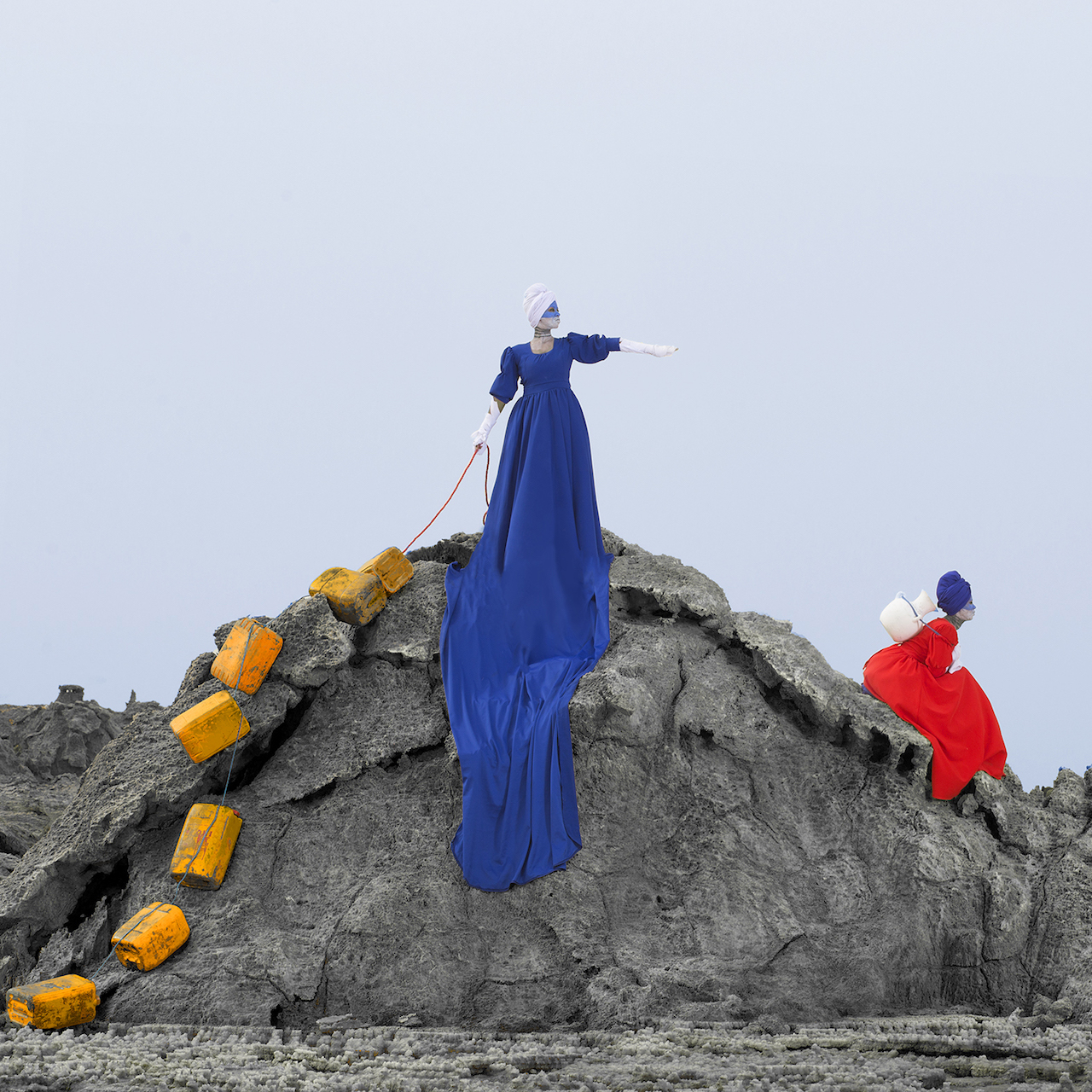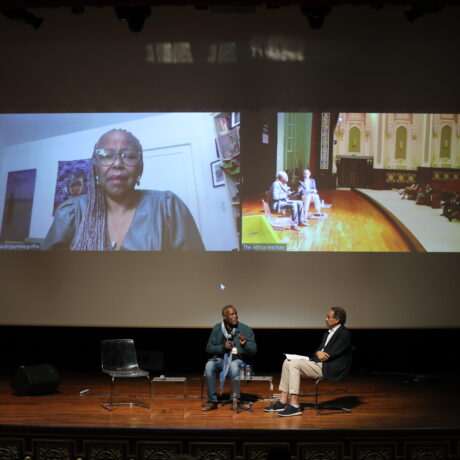
“I was interested in utilizing art as a form of advocacy,” photographer Aïda Muluneh tells me over the phone from Addis Ababa. We are discussing her commission for WaterAid, a charity that works to provide clean water and sanitation to communities across the globe. Muluneh made twelve images for the project, situating women against the landscapes of Dallol, in the Afar region of her native Ethiopia.
The women in Muluneh’s photographs are impassive and dignified and have a touch of glamour about them. In one of the most striking images, titled Star Shine, Moon Glow, the model sits cross-legged on the ground, a black and white striped path stretching out before her. She wears a bright blue dress and two lengths of red cloth fly up like wings. In the background, above the dramatic peaks, an enormous full moon rises in the sky. It might not look it at first glance, but this image is a subtle evocation of the water shortage on the African continent and its effect on women, but because of Muluneh’s unique vision, it avoids the usual clichés.
“Water is the foundation of everything in the household, but [obtaining it] is the burden of women”
She explains that many girls do not attend school while they are menstruating because of a lack of facilities and sanitation provision. The moon is symbolic of women’s monthly cycles and the red cloth rippling up in the breeze shows that the protagonist is a “caged bird, grounded” by her period. But there is hope; the striped path indicates a future route to success, a route she can take if things change, notably traditional domestic roles and the lack of readily available water. “Water is the foundation of everything in the household, but [obtaining it] is the burden of women and I’ve always found that surprising,” Muluneh tells me. “When you travel by car through the country you see long lines of women carrying it.”

Muluneh’s family left Ethiopia when she was just five years old, along with many others fleeing the country’s new communist regime. But after a peripatetic life spent in Yemen, Cyprus, the UK and Canada, she returned, eager to make a difference. “Coming back was really an educational process,” she tells me. “I think when we’re educated in the West we’re disconnected from our countries of birth and we come back with lofty ideas that don’t work, so that’s always a major challenge.”
Since her return around twelve years ago, Muluneh has been working hard to promote photography in Ethiopia, where, she says, most photographers make ends meet by covering weddings. “I only came for three months, but I realized that I would have to invest considerable time into sharing what I know in order to change things. It’s not enough to have exhibitions and do interviews, you have to be on the ground and be hands-on.” In 2010 she founded the Addis Photo Fest, the only such enterprise in East Africa. She also mentors young photographers, helping them build the skills and networks they need to succeed.
“Picasso took a lot from the continent, even though, at that time, the aesthetics of Africa were considered to be primitive”
Despite spending so long overseas, Muluneh never lost touch with the traditions of home. “In our house the culture was Ethiopian and it was important for my family to maintain that link.” That connection permeates her work with references to traditional art forms from across Africa. “Picasso took a lot from the continent,” she says, “even though, at that time, the aesthetics of Africa were considered to be primitive. To me they are highly sophisticated.” Muluneh borrows from Ethiopian fashions, too and styles from the 1930s and forties inspire the bright, billowing clothes worn by her models.
I ask Muluneh about the capes that appear in some of her images. They have pointed shoulders and standing collars and would not look out of place in a 1960s space odyssey. They, too, have their roots in Ethiopian trends of the last century, but her aim, she tells me, is to create a look that “transcends borders, geography, culture and class”, one that shows “the strength of women and the power we hold within”. Muluneh is conjuring a timeless world, but one that looks forward to the future. “I’m heavily influenced by science fiction,” she says, “and authors such as Octavia Butler, but most people can’t imagine a futurist Africa.”

Muluneh’s work can be understood within the genre of Afrofuturism, a term that encompasses music, film, fashion, art and literature. It merges aesthetics of the past and present with technologies and visions of the future. In the visual arts, two of the biggest names tied to the movement are British-Liberian painter Lina Iris Viktor and South African installation artist Mary Sibande; both have exhibitions in London this autumn. And it is women who are spearheading the rise in African art fairs, too. “The biggest asset the continent has, is its women,” Muluneh tells me, “but I don’t think we’ve realized that. The more educated our women become, the more our society will shift and development will move forward.”
“I’ve always been optimistic, but sometimes it’s challenging!”
This year Muluneh was selected by the film director Ava DuVernay to be featured in Time Magazine’s special issue on optimism. I ask if she feels optimistic about the future. “I’ve always been optimistic,” she says, “but sometimes it’s challenging! I don’t think the world will ever be perfect, but we have to strive to be as close to perfection in whatever capacity. It’s about finding a sense of purpose and for me that purpose is education.”




